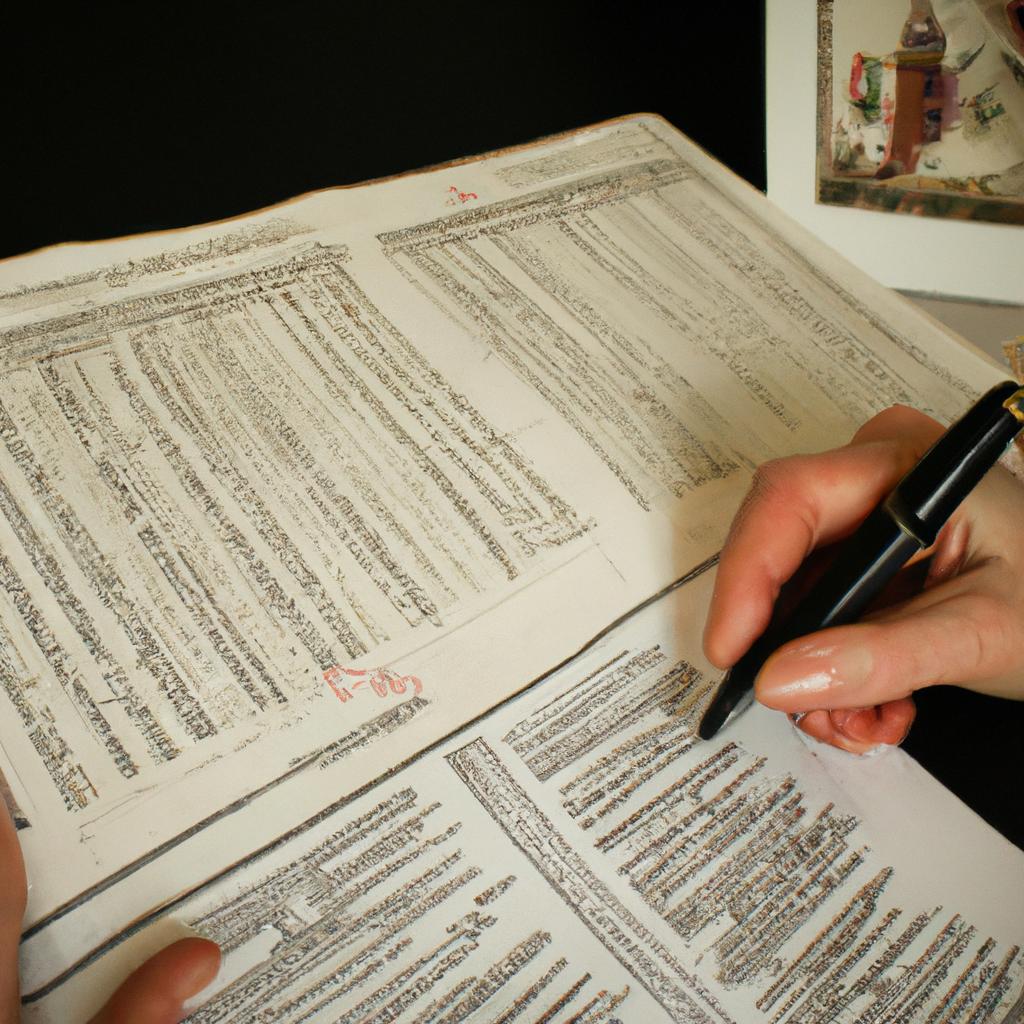The field of genealogy education is crucial in helping individuals uncover their ancestral roots and construct accurate family trees. The utilization of documents plays a pivotal role in this process, as they serve as key sources of evidence for tracing lineage and verifying connections between generations. For instance, consider the hypothetical case study of John Smith, who embarks on a journey to discover his family history. Through meticulous examination of birth certificates, marriage licenses, census records, and other primary sources, he can piece together an intricate narrative that sheds light on his ancestors’ origins and movements.
Understanding the significance of documents in genealogical research requires careful consideration of various factors. Firstly, the authenticity and reliability of these sources are essential elements to evaluate during the investigative process. Scholars emphasize the need for critical analysis when examining historical records to ensure accuracy and avoid misinterpretation or reliance on incorrect information. Additionally, comprehending the context surrounding each document aids in interpreting its meaning accurately. Factors such as time period, location, and societal norms influence the content within these materials and can provide valuable insights into familial relationships and events.
Furthermore, access to diverse types of documents broadens opportunities for comprehensive exploration in genealogy education. Beyond traditional government-issued records like birth certificates or death registers, alternative resources such as church records, immigration documents, military records, and newspaper archives can also provide valuable information. These sources often contain unique details not found in official government documents and can offer a more holistic understanding of an individual’s family history.
In genealogy education, it is essential to teach individuals how to effectively search for and analyze these various types of documents. This includes developing skills in conducting thorough research, utilizing online databases and repositories, and understanding the nuances of different record formats. Additionally, teaching individuals how to properly cite their sources ensures that their findings are transparent and reproducible by others in the field.
Lastly, the field of genealogy education should also emphasize the ethical considerations associated with document usage. Respecting privacy laws and guidelines when accessing sensitive or personal information is crucial. Moreover, recognizing the potential impact of sharing certain information on living relatives is important to ensure that ethical boundaries are not crossed.
Overall, genealogy education plays a vital role in equipping individuals with the necessary tools to navigate through various types of documents effectively. By fostering critical thinking skills, contextual understanding, and ethical awareness, aspiring genealogists can uncover their ancestral roots accurately while respecting privacy rights and maintaining integrity within the field.
Importance of Primary Sources
Importance of Primary Sources
Genealogy, the study of one’s ancestral lineage, relies heavily on accurate and reliable sources to piece together family histories. Among these sources, primary documents play a pivotal role in providing evidence that can corroborate or challenge existing genealogical knowledge. They offer direct access to information generated by individuals who were present during significant events, ensuring authenticity and credibility.
One example illustrating the importance of primary sources is the case of Sarah Thompson, an amateur genealogist eager to trace her family roots back several generations. She initially relied on secondary sources such as published books and online family trees but encountered conflicting information regarding her great-great-grandfather’s birthplace. Frustrated by this inconsistency, Sarah turned to primary documents for clarification. Through census records, baptismal certificates, and personal diaries obtained from local archives, she was able to verify her ancestor’s birthplace with certainty.
- Authenticity: Primary sources provide firsthand accounts of events or facts related to familial history.
- Accuracy: By relying on original documents rather than interpretations or summaries provided by others, researchers reduce the risk of errors or misinformation.
- Contextualization: These materials allow historians to place their findings within historical contexts accurately.
- Uniqueness: Every document possesses distinct characteristics that contribute valuable details not found elsewhere.
Moreover, a visual representation in the form of a table enhances comprehension and emotional engagement. The table below demonstrates how different types of primary sources yield specific insights into genealogical research:
| Document Type | Insights Provided |
|---|---|
| Census Records | Family composition over time; occupation; residence location |
| Birth Certificates | Names; dates; places of birth; parentage |
| Marriage Registers | Spousal names; dates; locations |
| Immigration Records | Arrival dates; ports of entry |
Understanding the crucial role played by primary sources in genealogy, researchers can delve into the subsequent section about “Understanding Genealogical Records.” By relying on these valuable resources, historians gain access to a wealth of information that is instrumental in constructing accurate and comprehensive family histories.
Understanding Genealogical Records
Having explored the significance of primary sources in genealogy education, we now turn our attention to another crucial aspect – understanding genealogical records. To illustrate its importance, let us consider a hypothetical case study involving an individual seeking information about their great-grandfather.
Paragraph 1:
In this scenario, our aspiring genealogist begins by examining census records from various time periods. These valuable resources provide essential details such as names, ages, occupations, and familial relationships. By carefully analyzing these records and cross-referencing them with other documents like birth or marriage certificates, the researcher can start piecing together a clearer picture of their ancestor’s life. However, it is important to note that discrepancies may arise due to misspellings or errors made during data collection. Thus, meticulousness and critical thinking are vital when interpreting genealogical records.
To emphasize the emotional impact of uncovering ancestral history through record analysis, consider the following:
- Discovering a long-lost branch of the family tree.
- Uncovering unexpected connections to historical events or notable figures.
- Validating personal stories passed down through generations.
- Shattering myths or assumptions previously held about one’s heritage.
| Types of Genealogical Records | Purpose |
|---|---|
| Census Records | Provide demographic information on individuals and families at specific points in time. |
| Birth/Marriage/Death Certificates | Document key life events and establish lineage between generations. |
| Military Service Records | Offer insights into an ancestor’s military service including rank, unit assignments, and awards received. |
| Immigration/Naturalization Records | Trace an individual’s journey to a new country or confirm citizenship status for multiple generations |
Paragraph 2:
Moreover, genealogical research often involves exploring specialized records tailored towards specific regions or populations. For instance, religious registers can disclose baptismal records, while land deeds offer insights into property ownership and transfers. Moreover, probate records shed light on inheritance patterns and the distribution of assets after an individual’s passing. By seeking out these diverse sources, genealogists widen their scope of inquiry and enhance their understanding of ancestral lineages.
Paragraph 3:
In summary, comprehending the intricacies of genealogical records is crucial for successful family history research. Through meticulous analysis and cross-referencing, researchers can overcome discrepancies in data to construct a more accurate narrative. Furthermore, by venturing beyond common records like census documents and birth certificates, one gains access to a wealth of specialized resources that provide unique perspectives on an ancestor’s life journey.
With a solid foundation in understanding genealogical records established, we now delve into effective research strategies that will assist aspiring genealogists in their quest for knowledge.
Effective Research Strategies
Transitioning from the previous section, where we explored the importance of understanding genealogical records, we now shift our focus to effective research strategies that can enhance one’s ability to uncover ancestral connections. To illustrate this, let us consider a hypothetical scenario involving an individual searching for information about their great-grandfather.
One key aspect of successful genealogical research is employing efficient search techniques. By utilizing various resources and approaches, researchers are more likely to obtain comprehensive results. These strategies may include:
- Utilizing online databases and archives
- Engaging with local historical societies or libraries
- Investigating census records and vital statistics documents
- Exploring personal family collections or heirlooms
To further understand the significance of these strategies, let us delve into a case study showcasing how they can contribute to genealogical breakthroughs:
Case Study:
A researcher named Sarah embarked on a journey to discover her great-grandfather’s origins. Armed with limited knowledge—a single photograph and oral history passed down through generations—she faced numerous hurdles along the way. However, by leveraging online databases, reaching out to local repositories, analyzing available census data, and conducting interviews within her extended family, Sarah pieced together fragments of information until she uncovered previously unknown details about her ancestor’s immigration story.
This case study highlights not only the potential impact of effective research strategies but also serves as inspiration for those embarking on similar quests for familial understanding.
As we continue exploring genealogy education, it is crucial to acknowledge that while strategy plays a pivotal role in research endeavors, navigating complex documents remains integral to success. In the following section titled “Utilizing DNA Testing in Genealogy,” we will explore another powerful tool that complements traditional document analysis methods without overshadowing their essential contributions.
Utilizing DNA Testing in Genealogy
Transitioning from the previous section on effective research strategies, it is imperative to acknowledge the pivotal role that primary source documents play in genealogical studies. These documents provide invaluable evidence and insights into ancestral lineage, enabling researchers to construct accurate family trees and unravel intricate connections across generations. By analyzing these historical records carefully, individuals can extract essential information that contributes significantly to their genealogical education.
To illustrate this point, let us consider a hypothetical scenario where an individual named Sarah embarks on a journey to trace her family history. Starting with limited information passed down through oral tradition, Sarah turns to primary source documents such as birth certificates, census records, and immigration registers. Through meticulous examination of these vital records, she discovers the true identity of her great-grandfather who had long been shrouded in mystery. This breakthrough not only fills gaps within her family tree but also unravels stories of resilience and triumph amidst adversity.
Emphasizing the significance of utilizing primary source documents in genealogical research, here are some key factors that underscore their importance:
- Authenticity: Primary sources offer firsthand accounts or direct evidence relating to specific events or individuals.
- Reliability: These documents often serve as official records maintained by governmental bodies or authoritative institutions.
- Contextualization: Examining primary sources enables researchers to gain insights into historical contexts, social conditions, and cultural practices prevalent during certain periods.
- Corroborative potential: Comparing multiple documents can help establish consistency or identify discrepancies, providing opportunities for further investigation.
Furthermore, incorporating a visual element can enhance engagement when exploring primary source materials. Consider the following table showcasing examples of common types of documentary evidence employed in genealogy research:
| Type of Document | Description | Example |
|---|---|---|
| Vital Records | Birth, marriage, and death certificates | Marriage certificate |
| Census Records | Population surveys conducted periodically | 1930 US Federal Census |
| Immigration Lists | Registers documenting arrivals in new countries | Ellis Island passenger list |
| Military Records | Enlistment and service information | WWII draft registration card |
In conclusion, primary source documents serve as crucial building blocks for genealogical education. Through their analysis, researchers can unravel family histories, fill gaps in ancestral knowledge, and gain a deeper understanding of the past. By applying effective research strategies alongside DNA testing, individuals can comprehensively explore their heritage.
Transitioning to the subsequent section on analyzing and interpreting documents, it is essential to delve into the intricacies of extracting meaningful insights from these historical records. By employing critical thinking skills and thorough examination techniques, researchers can unlock further layers of information hidden within each document.
Analyzing and Interpreting Documents
Utilizing DNA Testing in Genealogy has become an increasingly popular tool for individuals seeking to uncover their ancestral origins and connect with long-lost relatives. However, it is important to note that while DNA testing provides valuable insights into one’s genetic makeup, it should not be solely relied upon as the sole method of tracing family history. Analyzing and interpreting documents remains a crucial component in genealogical research, helping to piece together the puzzle of our past.
To illustrate the significance of document analysis, consider a hypothetical case study where an individual named Sarah is attempting to trace her lineage back several generations. While she may have taken a DNA test and received information about her ethnic background, this alone does not provide a complete picture of her ancestry. By analyzing various types of documents such as birth certificates, marriage records, census data, and immigration papers related to her ancestors, Sarah can gather vital clues about their lives and connections to other family members.
When examining these documents, certain key factors come into play:
-
Accuracy: Documents may contain errors or discrepancies due to human error during recordkeeping or transcription processes. It is essential to cross-reference multiple sources and critically evaluate each document’s reliability.
-
Context: Understanding the historical context surrounding a particular document is crucial for accurate interpretation. Factors such as prevalent naming conventions or changes in political boundaries can significantly impact how information is recorded.
-
Corroboration: Document analysis often involves comparing different sources against each other to establish consistency or identify inconsistencies. Corroborating evidence from diverse documents strengthens the credibility of findings.
-
Collaboration: Engaging with fellow researchers or joining genealogical societies can provide valuable insights and potential collaboration opportunities by sharing knowledge and resources.
Below is a table showcasing examples of various documents commonly utilized in genealogical research:
| Document Type | Purpose |
|---|---|
| Birth Certificate | Establishing date and place of birth |
| Marriage Record | Confirming marital relationships |
| Census Data | Tracing family members and residences |
| Immigration Papers | Identifying migration patterns |
By honing the skills of document analysis, genealogists can unlock a wealth of information that complements DNA testing results. However, it is important to recognize that both methods have their limitations and should be used in conjunction with each other for comprehensive research.
In the subsequent section on “Exploring Online Genealogy Resources,” we will delve into the vast array of digital tools available today, which further enhance genealogical investigations beyond traditional document analysis techniques.
Exploring Online Genealogy Resources
Transitioning from the previous section on analyzing and interpreting documents, we now delve into the importance of exploring online genealogy resources. To illustrate this point, let us consider a hypothetical case study involving an individual named Sarah who embarks on tracing her family history through digital platforms.
Sarah begins by searching for her great-grandfather’s name in an online genealogical database. She discovers a wealth of information, including census records, birth certificates, and even photographs. Through careful analysis and interpretation of these digitized documents, Sarah uncovers various details about her ancestor’s life – such as his occupation, place of residence, and familial connections. This process exemplifies how online resources can provide invaluable insights into one’s ancestry.
Exploring online genealogy resources offers several advantages over traditional paper-based methods. First, digital databases offer vast collections that are easily accessible at any time. Whether it is uncovering historical records or connecting with distant relatives through social networking features within dedicated genealogy websites, individuals like Sarah can efficiently navigate their ancestral paths without geographical limitations.
To further emphasize the benefits of utilizing online resources in genealogical research, here is a bullet-point list showcasing key factors:
- Extensive availability of digitized primary sources enables comprehensive exploration.
- Advanced search functionalities allow for targeted investigations based on specific criteria.
- Collaborative platforms foster connection with fellow researchers and facilitate knowledge exchange.
- Interactive features enable visualizations and mapping tools to enhance understanding.
In addition to these advantages, technology has also revolutionized the way data is presented in genealogical research. Consider the following table illustrating different types of online resources commonly utilized by researchers:
| Resource Type | Description | Example |
|---|---|---|
| Digitized Records | Scanned versions of original documents | Census records, birth certificates, marriage licenses |
| Online Forums | Platforms for collaboration and information sharing | Genealogy message boards, social media groups |
| Genetic Testing | DNA analysis to uncover ancestral connections | AncestryDNA, 23andMe |
By embracing these technological advancements in genealogy education and research, individuals like Sarah can delve deeper into their family history while fostering a sense of connection with the past. Through careful analysis and interpretation of online resources, they gain access to a wealth of knowledge that would have been arduous or even impossible to obtain using traditional methods.
Thus, as we explore the realm of online genealogy resources, it becomes evident that leveraging digital platforms opens up new avenues for discovery and provides researchers with an enriched understanding of their familial heritage.




